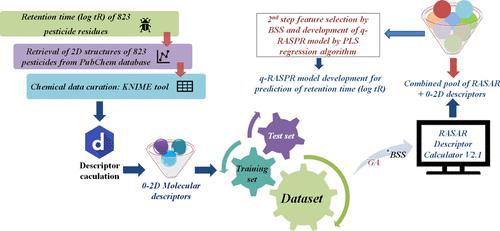当前位置:
X-MOL 学术
›
J. Agric. Food Chem.
›
论文详情
Our official English website, www.x-mol.net, welcomes your
feedback! (Note: you will need to create a separate account there.)
Predictive Quantitative Read-Across Structure–Property Relationship Modeling of the Retention Time (Log tR) of Pesticide Residues Present in Foods and Vegetables
Journal of Agricultural and Food Chemistry ( IF 5.7 ) Pub Date : 2023-06-09 , DOI: 10.1021/acs.jafc.3c01438 Shilpayan Ghosh 1 , Mainak Chatterjee 1 , Kunal Roy 1
Journal of Agricultural and Food Chemistry ( IF 5.7 ) Pub Date : 2023-06-09 , DOI: 10.1021/acs.jafc.3c01438 Shilpayan Ghosh 1 , Mainak Chatterjee 1 , Kunal Roy 1
Affiliation

|
The retention time (log tR) of pesticidal compounds in a reverse-phase high-performance liquid chromatography (HPLC) analysis has a direct relationship with lipophilicity, which could be related to the ecotoxicity potential of the compounds. The novel quantitative read-across structure–property relationship (q-RASPR) modeling approach uses similarity-based descriptors for predictive model generation. These models have been shown to enhance external predictivity in previous studies for several end points. The current study describes the development of a q-RASPR model using experimental retention time data (log tR) in the HPLC experiments of 823 environmentally significant pesticide residues collected from a large compound database. To model the retention time (log tR) end point, 0D–2D descriptors have been used along with the read-across-derived similarity descriptors. The developed partial least squares (PLS) model was rigorously validated by various internal and external validation metrics as recommended by the Organization for Economic Co-operation and Development (OECD). The final q-RASPR model is proven to be a good fit, robust, and externally predictive (ntrain = 618, R2 = 0.82, Q2LOO = 0.81, ntest = 205, and Q2F1 = 0.84) that literally outperforms the external predictivity of the previously reported quantitative structure–property relationship (QSPR) model. From the insights of modeled descriptors, lipophilicity is found to be the most important chemical property, which positively correlates with the retention time (log tR). Various other characteristics, such as the number of multiple bonds (nBM), graph density (GD), etc., have a substantial and inversely proportionate relationship with the retention time end point. The software tools utilized in this study are user-friendly, and most of them are free, which makes our methodology quite cost-effective when compared to experimentation. In a nutshell, to obtain better external predictivity, interpretability, and transferability, q-RASPR is an efficient technique that has the potential to be employed as a good alternative approach for retention time prediction and ecotoxicity potential identification.
中文翻译:

食品和蔬菜中农药残留保留时间 (Log tR) 的预测定量跨结构-性质关系模型
反相高效液相色谱 (HPLC) 分析中农药化合物的保留时间(log t R ) 与亲脂性有直接关系,这可能与化合物的潜在生态毒性有关。新颖的定量跨结构-性质关系(q-RASPR)建模方法使用基于相似性的描述符来生成预测模型。在之前的研究中,这些模型已被证明可以增强多个终点的外部预测能力。当前的研究描述了使用实验保留时间数据(log t R)对从大型化合物数据库中收集的 823 种对环境有重要影响的农药残留物进行 HPLC 实验。为了对保留时间 (log t R ) 终点进行建模,使用了 0D–2D 描述符以及跨读取导出的相似性描述符。所开发的偏最小二乘 (PLS) 模型按照经济合作与发展组织 (OECD) 的建议通过各种内部和外部验证指标进行了严格验证。最终的 q-RASPR 模型被证明是一个很好的拟合、鲁棒性和外部预测性(n train = 618,R 2 = 0.82,Q 2 LOO = 0.81,n test = 205,并且Q2 F1 = 0.84),这实际上优于先前报道的定量结构-性质关系(QSPR)模型的外部预测能力。根据建模描述符的见解,发现亲脂性是最重要的化学性质,它与保留时间呈正相关(log t R)。各种其他特征,例如多重键数 (nBM)、图形密度 (GD) 等,与保留时间终点具有显着的反比关系。本研究中使用的软件工具易于使用,并且大多数都是免费的,这使得我们的方法与实验相比相当具有成本效益。简而言之,为了获得更好的外部预测性、可解释性和可转移性,q-RASPR 是一种有效的技术,有可能成为保留时间预测和生态毒性潜在识别的良好替代方法。
更新日期:2023-06-09
中文翻译:

食品和蔬菜中农药残留保留时间 (Log tR) 的预测定量跨结构-性质关系模型
反相高效液相色谱 (HPLC) 分析中农药化合物的保留时间(log t R ) 与亲脂性有直接关系,这可能与化合物的潜在生态毒性有关。新颖的定量跨结构-性质关系(q-RASPR)建模方法使用基于相似性的描述符来生成预测模型。在之前的研究中,这些模型已被证明可以增强多个终点的外部预测能力。当前的研究描述了使用实验保留时间数据(log t R)对从大型化合物数据库中收集的 823 种对环境有重要影响的农药残留物进行 HPLC 实验。为了对保留时间 (log t R ) 终点进行建模,使用了 0D–2D 描述符以及跨读取导出的相似性描述符。所开发的偏最小二乘 (PLS) 模型按照经济合作与发展组织 (OECD) 的建议通过各种内部和外部验证指标进行了严格验证。最终的 q-RASPR 模型被证明是一个很好的拟合、鲁棒性和外部预测性(n train = 618,R 2 = 0.82,Q 2 LOO = 0.81,n test = 205,并且Q2 F1 = 0.84),这实际上优于先前报道的定量结构-性质关系(QSPR)模型的外部预测能力。根据建模描述符的见解,发现亲脂性是最重要的化学性质,它与保留时间呈正相关(log t R)。各种其他特征,例如多重键数 (nBM)、图形密度 (GD) 等,与保留时间终点具有显着的反比关系。本研究中使用的软件工具易于使用,并且大多数都是免费的,这使得我们的方法与实验相比相当具有成本效益。简而言之,为了获得更好的外部预测性、可解释性和可转移性,q-RASPR 是一种有效的技术,有可能成为保留时间预测和生态毒性潜在识别的良好替代方法。







































 京公网安备 11010802027423号
京公网安备 11010802027423号